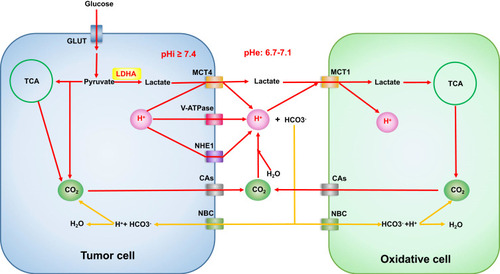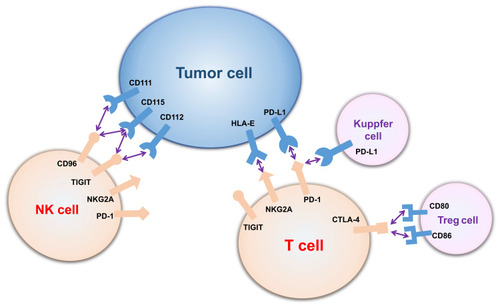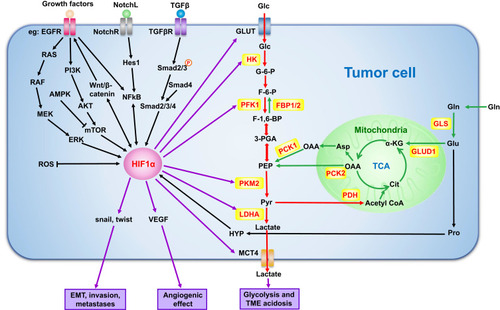Figures & data
Figure 1 Overview of tumor acid-base microenvironment. OXPHOS of the oxidative cells is a compensatory mechanism of tumor acidosis, but the acidosis cannot be reversed.
Abbreviations: GLUT, glucose transporters; TCA, tricarboxylic acid cycle; LDH-A, lactate dehydrogenase A; MCT4, monocarboxylate transporter4; MCT1, monocarboxylate transporter1; V-ATPase, vacuolar ATPase; NHE1, sodium-hydrogen exchanger1; CAs, carbonic anhydrases; NBC, sodium bicarbonate cotransporters.

Figure 2 Interaction between tumor cells and immune cells by immune checkpoints. T cells and NK cells express various immune checkpoints, which can bind to ligands on tumor cells, Treg cells and Kupffer cells and be inhibited (CD96 binds to CD111 and CD115; TIGHT binds to CD115 and CD112; NKG2A binds to HLA-E; PD-1 binds to PD-L1; and CTLA-4 binds to CD80 and CD86).
Abbreviations: PD-1, programmed death-1; CTLA-4, cytolytic T lymphocyte-associated antigen-4; NKG2A, natural killer cell group 2A; TIGIT, T-cell immunoglobulin and ITIM domain; HLA-E, human leukocyte antigen-E.

Figure 3 Mechanisms of glycolysis regulation by HIF-1α and gluconeogenesis in tumor cells. HIF-1α can directly regulate glycolysis-related enzymes to affect tumor cell glucose metabolism. It can also affect tumor growth and metastasis by regulating the level of active oxygen, EMT and angiogenesis. In addition, cytokines, signaling pathways and glutamine, which play an important role in tumor, can also regulate the biological activity of tumor cells by influencing HIF-1α. Black arrows: pathways regulating HIF-1α; Red arrows: glycolysis-related processes; Green arrows: gluconeogenesis-related processes.
Abbreviations: GLS, glutaminase; GLUD1, glutamate dehydrogenase; αKG, α-ketoglutarate; TCA, tricarboxylic acid; GLUT1, glucose transporter1; PFK1, phosphofructokinase; PKM2, pyruvate kinase M2; LDHA, lactate dehydrogenase A; MCT4, monocarboxylate transporter4; VEGF, vascular endothelial growth factor; EMT, epithelial-to-mesenchymal transition; HIF-1α, hypoxia-inducible factor-1α; ICN, the intracelluIar domain of Notch; Glc, glucose; G-6-P, glucose-6-phosphate; F-6-P, fructose-6-phosphate; F-1,6-BP, fructose-1,6-bisphosphate; 3-PGA, glyceraldehyde-3-phosphate; PEP, phosphoenolpyruvate; Pyr, pyruvate; Cit, citrate; OAA, oxaloacetic acid; Asp, asparagine; Glu, glutamate; Gln, glutamine; Pro, proline; HYP, hydroxyproline; NotchL, Notch ligand; NotchR, Notch receptor.

